What happens when a mold remediation company simply cannot do the job? Is it always wise to hire the cheapest and most inexpensive company? What if, after repeated attempts, the remediation company cannot solve the issue? Do they have the resources to continue to soldier on and remediate until the structure is free of all mold? These are valid questions that a purchaser of mold remediation services should ask. At ServiceMaster Advanced, we have years of SUCCESSFUL mold remediation projects. We have references and pictures of our work and professionalism. We have the depth of management, expertise and national guidance to solve even the most confounding mold issues. We have the depth of sheer size to continue to work and solve issues, even if it means we have to honor our own underestimated quote. How many companies will stick by their binding quotation when they find that there is unexpectedly more than the anticipated work to be done. At ServiceMaster Advanced, our quote is our bond.
When should I seek mold testing & remediation? Gulf Coast of Alabama & Mississippi (251) 653-9333
The question of when to call a professional for mold identification and testing is a tricky one. Many remediation companies such as ours, are reluctant to publish anything saying that says that you should go it alone; and that your particular problem doesn't require a professional. For liability reasons, if you suspect that you have a mold issue, we want to start with this blanket statement: "Call a registered industrial hygienist to test, or call a mold remediation company to do an inspection." Your health should not be compromised by breathing mold spores.
The contents of this article include some information on the types of mold, cleaning contents and furnishings, and methodology. We hope you will find the enclosed information educational.
We realize that you might want to call around for mold advice. We encourage it. Just make sure you call us as well. ServiceMaster Advanced Cleaning & Restoration (251) 653-9333, (251) 928-1028, or (251) 943-2230. This is one place that will give you honest answers. We guarantee it.
Before you read this entire article, remember just a few things. We are not trying to ''sell" you anything. NO one can tell you how severe your problem is without SEEING IT, and testing the AIR QUALITY. No one can take short cuts by simply removing affected drywall - the spores that remain in the air are what is potentially harmful. Finally, no one can tell you how the different types of mold will affect yourhealth- (everyone is different - don't let anyone try to scare you); we can only give you advice. If we have your attention, read on. We are here to help and get you the best possible advice.


On the subject of mold remediation, and mold information in general, it is the duty and quest of ServiceMaster Advanced Cleaning & Restoration, to educate our customers and the public as much as possible. There is a lot of information published about mold. We believe the consumer should educate themselves, and obtain information from a variety of sources. We believe that after the consumer has done their homework, they will clearly understand why our approach is one of extreme caution, with the health of the individual as our first and foremost concern.

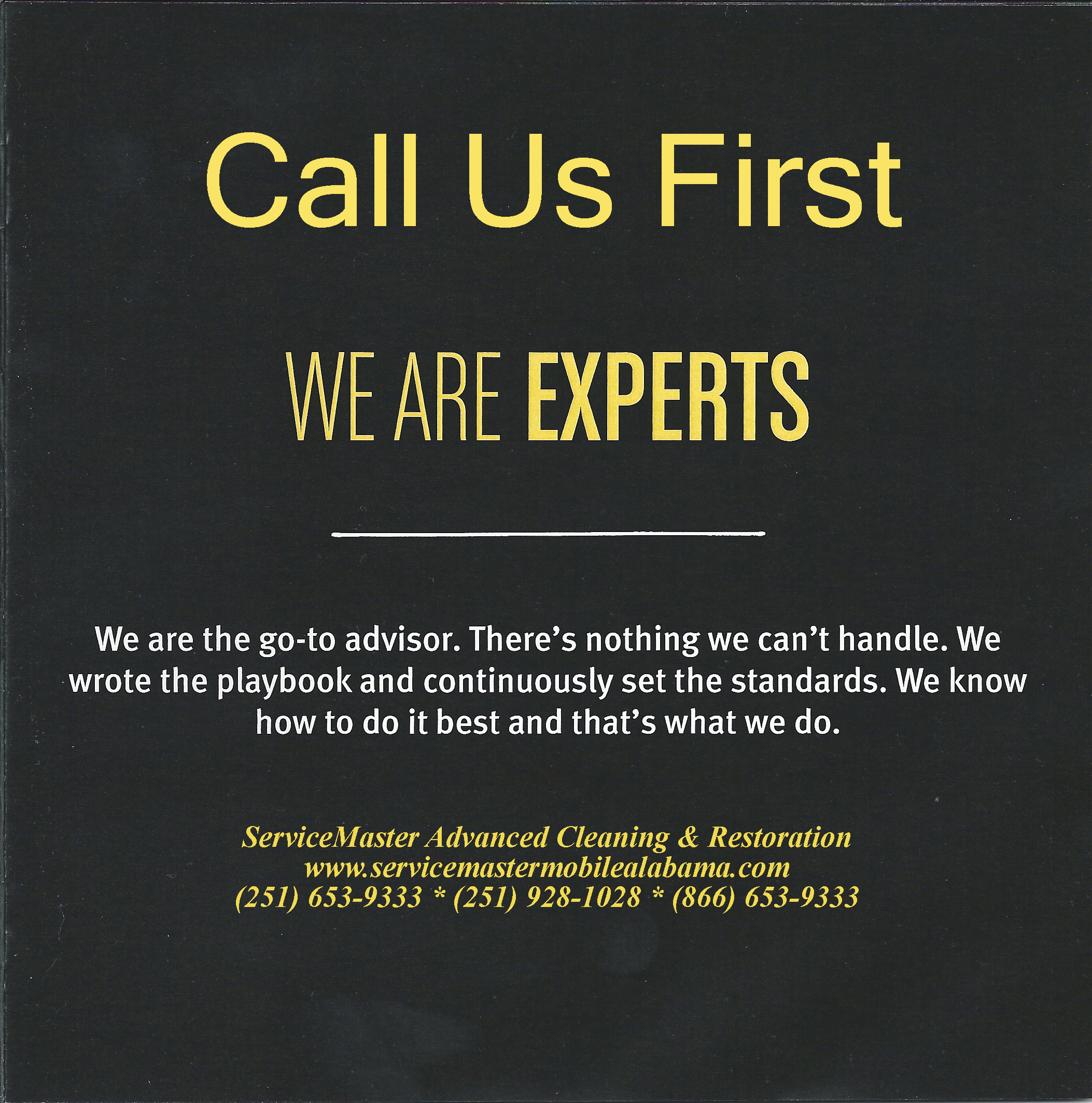
Before You Hire A Mold Remediation Company, read this.
CERTIFIED Mold Remediation Requires Training & Knowledge
If you have a mold issue, make certain that you hire a CERTIFIED mold remediation professional. Ask to see their certifications. Ask to see their insurance. Mold can be a serious health hazard, and you shouldn't take a chance with anyone that says it can simply be torn out! The airborne spores left from the removal of affected drywall and contents, are typically the very thing that will cause health problems. If every square inch isn't properly cleaned and the air filtered, the resulting spores can be enough to cause serious health issues. We will not take a chance with your health. We only know one way to do the job - the right way. This involves total elimination and removal of all visible and airborne mold spores. - ServiceMaster Advanced - The Master of Disaster (251) 653-9333, (251) 928-1028.
In this posting, we have combined several articles. We hope you find them helpful.


ServiceMaster believes in doing mold remediation the right way. This means calling in an independent Industrial Hygienist and having the customer hire them to do “before and after” air sampling, and write a proper mold remediation protocol. Typically, collection of air and or tape samples will be done. Here is an initial report prior to remediation:
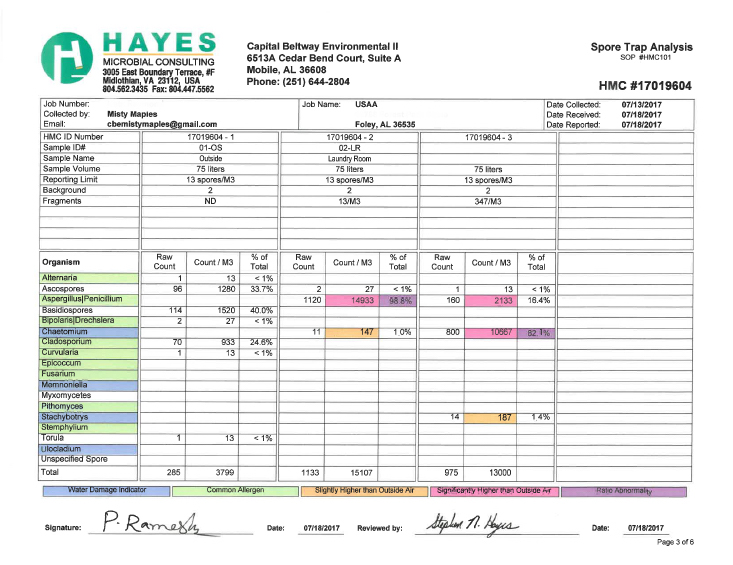
At this point, a proper mold remediation protocol will be written. This is an extensive, SPECIFIC document, detailing exactly what will be done. Specifically, which walls need to be removed, which areas can be cleaned, the duct work to be cleaned and where containment should be set up. Since these documents are quite lengthy (often several pages), we have elected not to include a sample document in this article. We will gladly provide one for a prospective customer.
After the protocol has been followed to the letter, and the remediation has been completed, then the structure is retested. Here is an example of the same structure as above, after mold remediation is completed:
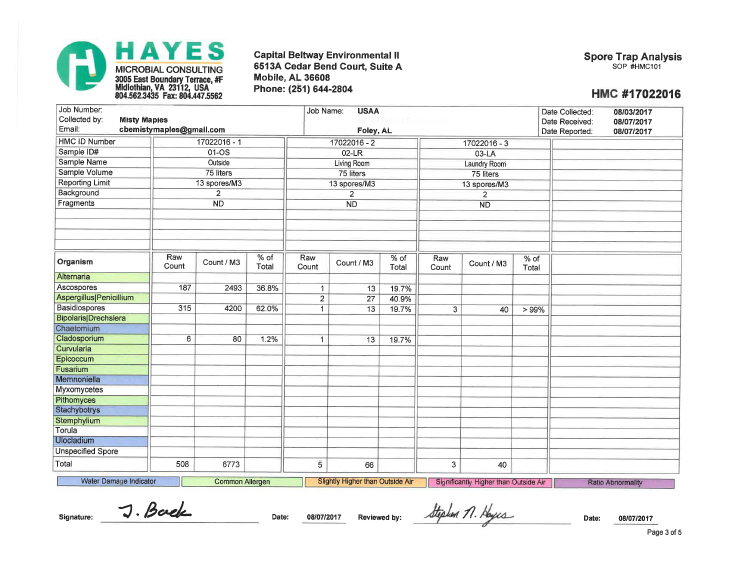
Close examination of the air samples collected and the report issued, are indicative of nearly complete removal of all mold spores. in fact, the air inside is now cleaner than the outside air!

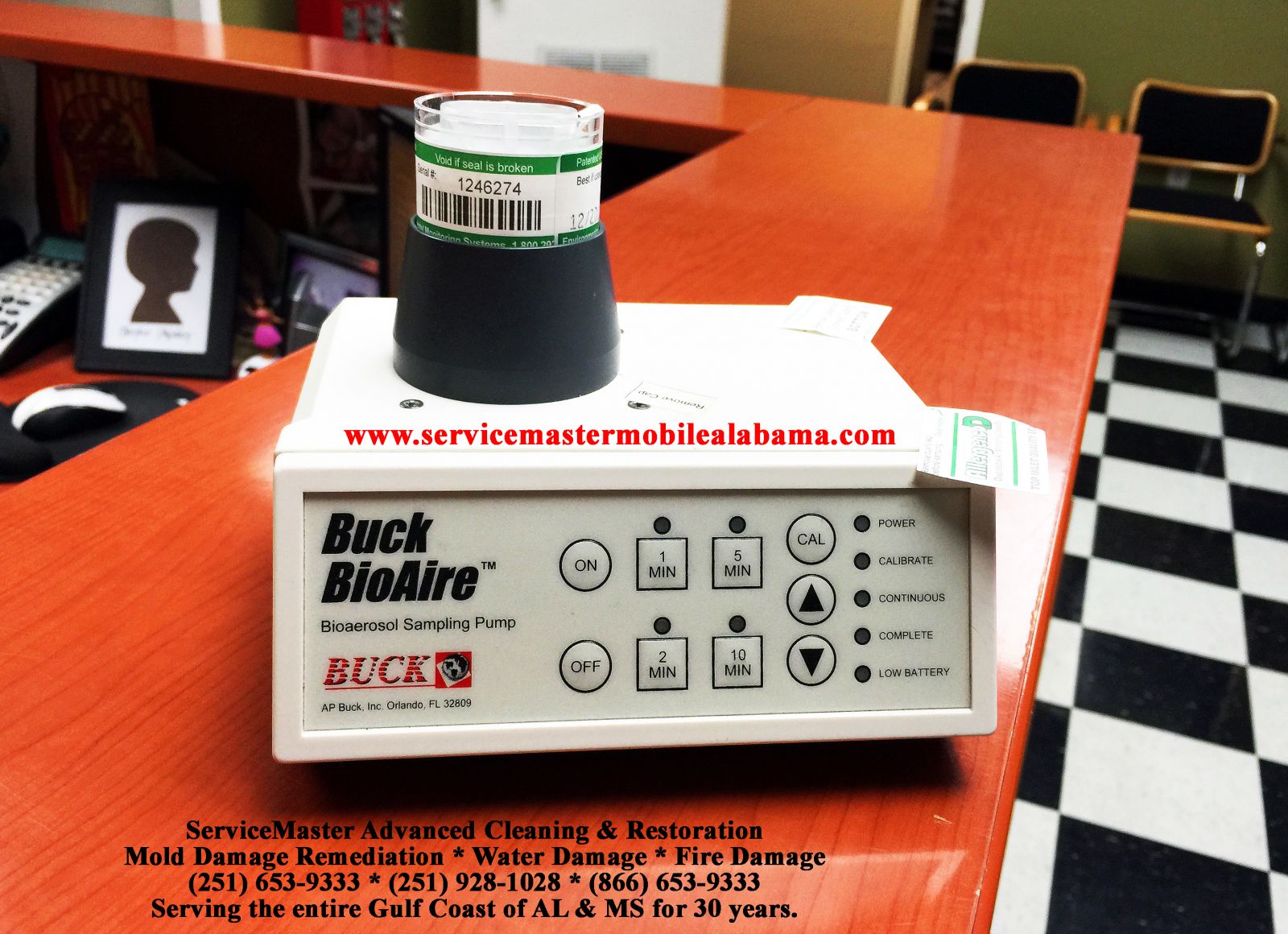
Mold air sampling machine.
Mold Overview - Types of Mold Explained - ServiceMaster ADVANCED - Mobile, AL
We are the original ServiceMaster Restore disaster restoration company operating in Mobile and Baldwin County in South Alabama, serving the area for over 30 years. We have handled some of the largest fire damage, water damage and mold remediation cleanup jobs ever performed on the Gulf Coast and we would be honored to serve you. (251) 653-9333, (251) 928-1028 and (866) 653-9333.

.jpg)
Below is an article posted on LinkedIn by Mr. Sanjay Gupta. it is an overview and gives the reader some basic information. Another great site is http://www.epa.gov/mold/. There is a link to his site included below.


BEGIN ARTICLE
Mold Facts and Information
Originally published on June 5, 2015. by Sanjay Gupta
The purpose of this article is to answer the following questions about mold:
1. What causes mold growth?
2. What are the most common types and species of mold?
3. Why should I be concerned about mold?
4. How can I detect mold?
What Causes Mold Growth?
Mold is a fungus, as are mushrooms and yeast, and has a biological purpose in our eco-system: to consumes dead organic material. Understanding it’s biological importance is essential to understanding why it poses health hazards.
Problems occur with mold when it begins growing in an enclosed environment such as a home. Mold found inside homes and buildings originates from the outside. Mold spores enter buildings and homes through open doorways, windows, heating, ventilation and air conditioning systems. Spores in the air outside also attach themselves to clothing, animals, shoes, bags and more!
The key ingredient mold needs to thrive and grow is moisture and a food source.
Sources of Moisture
Since mold is everywhere, it will only start growing when the spores settle on surfaces with excess moisture. The key to preventing mold growth is to control moisture. Maintaining an interior humidity level of between 30 to 40% will prevent mold growth.
Listed below are the most common sources of moisture. If you suspect mold growth, before the mold can be cleaned and removed, the sources of the moisture issues must be addressed first.
1. Flooding.
2. Backed-up sewers.
3. Leaky roofs and/or water leaks.
4. Humidifier which is not regularly cleaned and disinfected.
5. Damp basements or crawl spaces.
6. House plants and their debris.
7. Steam from cooking and showers.
8. Wet clothes hung to dry indoors.
9. Inadequate air exchange.
10. Excessive humidity.
11. Condensation, which is especially a problem during the winter, on poorly insulated surfaces.
Sources of Food
Mold is like a parasite because it will only grow if there is an ample mold source. Under the right conditions of temperature and moisture, mold will continue to feed. The problem with mold lies in the fact that most homes and buildings are made from dead organic material, which is the type of food that mold thrives on. Food sources for mold include the following:
1. Wood & wood products.
2. Paper and other paper products like cardboard and wallpaper
3. Leather.
4. Fabric and upholstery
5. Grout.
6. Painted walls.
7. Cement
8. Plaster (drywall).
9. Ceiling tiles
10. Insulation materials.
11. Carpet.
What Are The Most Common Types and Species of Mold?
Not all molds are the same; consequently, it is important to understand that identifying the types and species of mold is important because it helps you and the mold remediation professionals assess the potential health hazards that the growth poses.
Types of Mold
Of the 100,000 types of mold that have been identified, the three most common types have been identified as:
1. Allergenic Molds.
2. Pathogenic Molds.
3. Toxigenic Molds.
Allergenic Molds
Allergenic molds are not usually life-threatening but do cause health concerns for individuals with allergies or asthma. Children and the elderly are most likely to experience health issues if there are allergenic molds present in the property.
Pathogenic Molds
Pathogenic molds are of particular concern if your immune system is weak or compromised because these can cause infections. This type of mold can cause hypersensitivity pneumonitis, an acute response resembling bacterial pneumonia. An example is Aspergillus fumigatus, which can grow in the lungs of immune-compromised individuals.
Toxigenic Molds (aka “toxic molds”)
Toxigenic molds are the worse types of molds because they produce mycotoxins that will make anyone exposed to them sick. Mycotoxins are chemical toxins present within or on the surface of the mold spore, which can be inhaled, ingested, or touched. An example of this is an aflatoxin, one of the most potent carcinogens known to mankind. Aflatoxins grow on peanuts and grains, and on some other foods.
Species of Mold
Mold inspectors and indoor air quality professionals use various methods to identify the mold species.
Testing could be done with a tape or swab sample on visible mold.
Air quality samples may also be recommended because air borne mold spores are not visible to the eye. Air quality samples are advantageous because they can identify the concentration of indoor spores.
Once samples are taken, they should be sent to accredited laboratories to analyze them to determine the exact species of mold.
The five most prevalent species of mold are:
1. Alternaria.
2. Aspergillus.
3. Cladosporium.
4. Penicillium.
5. Stachybotrys.
Alternaria Mold
Alternaria mold is commonly found in your nose, mouth and upper respiratory tract and can cause allergic responses.
Aspergillus Mold
Aspergillus mold is usually found in warm, extremely damp climates, and a common occupant of house dust. This mold produces mycotoxins which is a poisonous chemical compound. This mold variety can cause lung infections including aspergillosis.
Cladosporium Mold
Cladosporium mold is a very common outdoor fungus that can find its way indoors and grow on textiles, wood and other damp, porous materials. This mold triggers hay fever and asthma symptoms.
Penicillium Mold
Penicillium mold is a very common species found on wallpaper, decaying fabrics, carpet, and fiberglass duct insulation. It is known for causing allergies and asthma. Some species produce mycotoxins, one being the common antibiotic penicillin.
Stachybotrys Mold
Stachybotrys mold is extremely toxic “black mold” that produces mycotoxins that can cause serious breathing difficulties and bleeding of the lungs. This mold can be found on wood or paper.
END OF ARTICLE
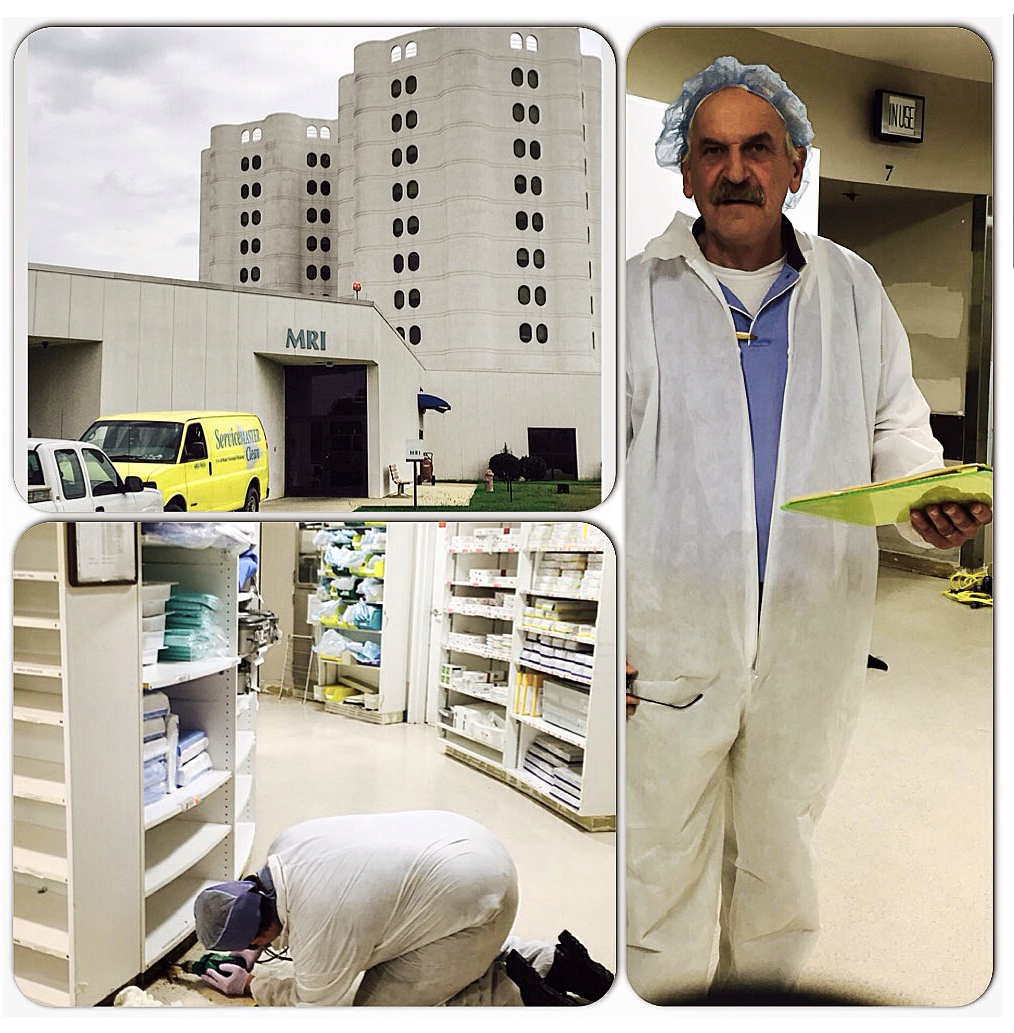

We are the original ServiceMaster Clean (janitorial) & ServiceMaster Restore (disaster restoration) company operating in Mobile and Baldwin County in South Alabama, serving the area for over 30 years. We have handled some of the largest janitorial, fire damage, water damage and mold remediation cleanup jobs ever performed on the Gulf Coast and we would be honored to serve you. (251) 344-5105, (251) 653-9333, (251) 928-1028 and (866) 653-9333.
.jpg)
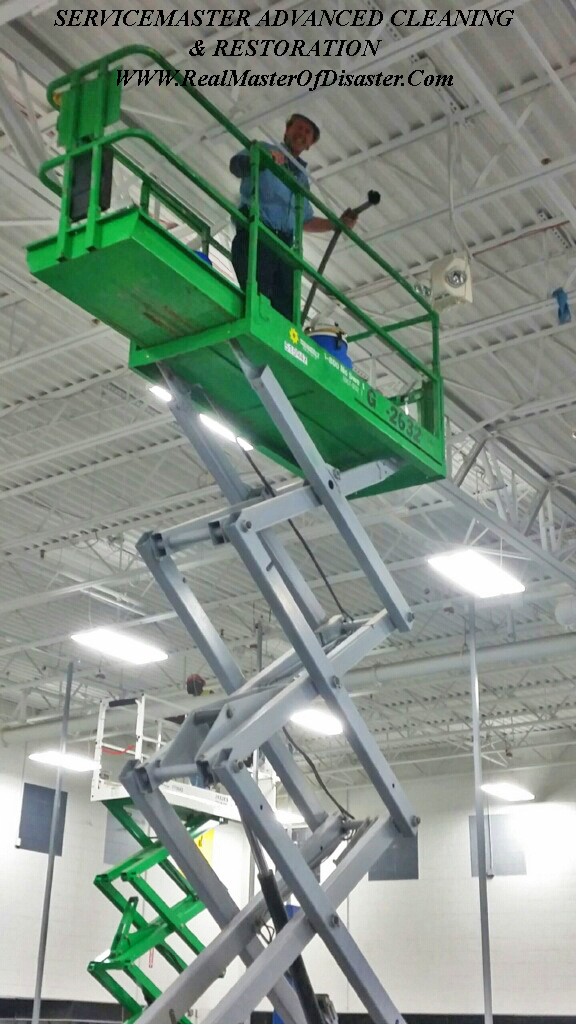
END OF ARTICLE


How To Clean Mold Contaminated Contents!
Article originally published on August 22nd, 2015 at www.moldsensitized.com
The Contents Conundrum*
This article was originally published by Contents Industry Review, Your Source for the Latest Contents Restoration News, Trends and Developments. Many thanks to David Gavilanes for his assistance. Image courtesy of Contents Industry Review.
Deciding if contents from structures with mold growth are contaminated, and what to do about them
Too often, contents are the forgotten stepchild of a mold remediation project. Inspectors and Indoor Environmental Professionals often focus on identifying the source of water intrusion and the subsequent fungal contamination with little regard for the furnishings and contents in the areas surrounding the contamination. Many project specifications talk about isolation of contaminated area with brief instructions (or the assumption) for movable contents to be repositioned so that they are not inside the isolated work zone.
Unfortunately, improperly assessed or addressed contents can be a source of significant cross-contamination to areas where considerable effort and expense has been expended to deal with mold contamination. This is an especially crucial issue if any of the occupants aresensitized to mold (or have Lyme disease or chemical sensitivity, either of which can result in cross sensitivities to mold). Therefore, regardless of whether the contents are addressed in the work plan of a third-party, cleaning and restoration contractors need to have some basic guidelines for attending to them when dealing with water damage and mold remediation projects.
The Initial Assessment
Even if contents are only being moved from one area to another as part of the setup for a mold remediation project, close attention should be paid to each and every item. Any material that has visible fungal growth (or anything that resembles fungal growth), a musty odor, or a “light fuzz” that could be dust deposition or mildew should immediately be segregated from the other materials. Of the items with visible contamination, nonporous materials can generally be cleaned satisfactorily. In contrast, the current standard of care calls for the disposal and replacement of soft, porous contents that are supporting fungal colonies.
Even if the contents do not have visible growth on them, they could still be reservoirs of fungal contaminants like spores, hyphae, and mycotoxins (chemical poisons that can be released from some fungal types). This microscopic contamination is characterized as Condition 2 by the IICRC’s S520 standard related to professional mold remediation. The S520 notes that dust from impacted items does not reflect the “normal fungal ecology” in terms of fungal types present and amounts. However, the good news is that the S520 document explains that contents contaminated by deposition of spores from adjacent growth can be cleaned.
Standard of Care versus the Doctor’s Recommendation
While many professionals in the cleaning and restoration industry are used to cleaning contents that at first glance seem to be unsalvageable, the reverse thinking often takes hold of occupants who are dealing with a mold contamination situation. Even in cases where the contents do not have visible fungal growth, they are concerned that the materials cannot be thoroughly decontaminated. Indeed, we have talked to several individuals, diagnosed with mold sensitivities, who were told by their doctors that the contents of their homes could never be cleaned well enough. The medical professional basically told them that all of those items needed to be disposed of.
In contrast, our research and experience confirm that contents acting as a reservoir for fungal contamination generally can be cleaned. However, from a practical and financial standpoint the general rule of thumb that we use when offering advice to clients is that the more contents that can be removed from the house, the more thorough the cleaning of both contents and the structure can be. Nevertheless, there are practical limitations. Large bureaus, beds, couches, and appliances are difficult to move, even to a cleaning station in the garage. Large pieces that are left in the house need to be thoroughly cleaned and then moved multiple times during the process of cleaning the structure. We do not recommend that they be covered and left in place because this hinders the proper cleaning of all surfaces.
Another important consideration is that the more consistent the occupant and cleaning contractor can be with surfaces and contents, the better the result for sensitized individuals.For both surfaces and contents, the process should begin with a HEPA sandwich method of cleaning. Additional activities for both the structure and any remaining contents can include air scrubbing, air washing, and fogging.
Using a Logical Process
As most cleaning and restoration contractors understand, once the decision has been made to undertake cleaning of some or all of the contents, a number of other questions come into play.Probably the biggest variable that needs to be determined is where and how the content cleaning will be accomplished. There are a few options:
1. Clean them on the way out of the house. This typically involves setting up a cleaning station in the garage or other area where contaminated contents from the house are staged, cleaned, and packed in clean containers. Although we prefer that plastic tubs with tightfitting lids be used as storage containers, cardboard boxes can be used as long as they are lined with plastic to protect the contents from moisture. Generally, the packing containers used on the way out of the house are not an issue—even old grocery boxes can be used, but after the items have been cleaned they should be stored and moved around in new boxes or plastic containers.
Some clients have even gone so far as to set up a washer and dryer in the garage with temporary water and power sources so that methodical cleaning can be conducted. We recommend, however, that any soft contents being saved be cleaned using the Esporta Wash System rather than regular washers and dryers. This is because that is the only system that we are aware of that has published data on the efficacy of cleaning mold reservoirs (as well as actual visible contamination) from soft goods.
2. Pack them and have them cleaned at a separate facility. The benefit to this approach is that the contents can then be cleaned utilizing a wide variety of specialized decontamination processes. In particular, this allows materials to be moved to a facility that has specialized laundry equipment, ultrasonic cleaning tanks, proper cleaning equipment for electronic components, and even areas for specialty cleaning of papers and books. Also available at some facilities, household contents can be subjected to other cleaning and decontamination procedures as appropriate, such as controlled exposure to ozone or hydroxyl radicals.
3. Pack the contents, store them until remediation has been completed, and then clean them on-site as they are moved back into the clean residence. While this approach has the benefit of the items being cleaned immediately before their reentry into the remediated structure, it does limit the cleaning methods that can be used. The biggest drawback to this approach is that many of the specialized cleaning procedures mentioned in the previous option are not practical at temporary locations.
Once a decision has been made as to how and where the contents will be cleaned, it is much easier to proceed with packing. In all cases, it is best to view this situation as an opportunity for the clients to de-clutter their lives. Content cleaning gets progressively more expensive as the number of items increases. Also, it is important to educate the client that, from a mold perspective, paper goods are the most difficult to clean properly and, therefore, are the most expensive. But for almost everything else, studies have shown that cleaning contaminated items costs only 20–25% as much as replacing them.
Selection of Cleaning Products/Processes
Regardless of whether it is hard goods or soft goods, a decision needs to be made about the particular cleaning agents that will be employed. While a good HEPA vacuum should always be used to remove loose particles from contents, a damp or wet cleaning method is also recommended for materials from a mold-contaminated structure. One of the primary reasons for this washing is the debate in the industry about what role residual mycotoxins play in the development of adverse health symptoms. Research over the past seven years has shown that some of the more noxious mycotoxins can not only be spread through the air, but when they settle on surfaces they tend to cling to that surface until the attraction is broken through chemical and physical methods. (This means that if there are sporting goods, such as a croquet set, in a mold-contaminated environment you could have a real sticky wicket on your hands!**)

.jpg)
For this reason antimicrobials that are formulated from quaternary ammonium compounds (quats) are often recommended for cleaning contents and surfaces in mold contamination situations. Quats are recommended for mold work because some research suggests that they are better than regular cleaners at removing mycotoxins from surfaces. Nevertheless, the oxidation potential of hydrogen peroxide based cleaners would, theoretically, also work to break that sticky bond between the mycotoxins and the surfaces.
Essential oil cleaners are another frequent choice for mold work. While their effectiveness against microorganisms is well documented, there is little available evidence about their ability to remove mycotoxins. Another class of cleaning products being used for mold remediation are salt-based products. However, once again, there is little available evidence about their ability to remove mycotoxins.
Cleaning Contents May Not Be a “Do It Yourself” Proposition
People who are considering cleaning household contents related to mold contamination situations for the first time rarely think that there is any sort of conundrum associated with the work. The reality is that cleaning these contents can pose a variety of unexpected difficulties and needs to be well thought out.


While this article contains a lot of information to digest, it also points out that the cleaning and restoration industry is blessed with a great variety of good products that work well in specific aspects of the mold remediation business. Contractors and occupants just have to choose wisely based on their particular situation. For sensitized individuals, this may mean that what at first appears to be a simple task of cleaning dust and fungal reservoirs from contents is actually something that they should leave to the professionals.
Another great source of information is: http://www.epa.gov/mold/.
END OF ARTICLE
Finally, at the risk of being redundant and providing too much information, we have put together a printable quick-start mold remediation guide and posted it below:



About ServiceMaster ADVANCED Cleaning & Restoration, The Master of Disaster.
The owner of ServiceMaster Advanced is certified in mold remediation. It is absolutely imperative that you hire someone who is certified and understands both how to remediate mold, and the health consequences of mold. We have done many many residential and commercial mold remediation jobs and we always get a certified industrial hygienist to provide clearance testing.
Based out of Mobile AL and Foley, AL, we serve the entire local area including Mobile, Citronelle, Saraland, Satsuma, Chickasaw, Prichard, Eight Mile, Semmes, Theodore, Grand Bay, Irvington, Bayou La Batre, Dauphin Island, Bay Minette, Loxley, Stapleton, Spanish Fort, Daphne, Lillian, Fairhope, Silver Hill, Foley, Elberta, Seminole, Magnolia Springs, Orange Beach, Perdido Key, Gulf Shores and every community in Mobile and Baldwin Counties in South Alabama; and Pascagoula, Gulfport, Biloxi and every community in Jackson and Harrison Counties in Mississippi.
Our web site is loaded with informative articles and videos on mold remediation. Please view our site at: http://www.servicemastermobilealabama.com. It will give you a good idea of our standards. Also, please check the EPA guide on mold: http://www.epa.gov/mold/moldguide.htm. You will find that we absolutely adhere to the guidelines in this publication.



When you call us, we will assess your issue, direct you to an independent testing company if necessary, and immediately contain the affected area if necessary. We only know one way to do the job - the right way.
Remember that YOU AND YOU ALONE, decide who works in your home or business. YOU decide who can most effectively handle your cleanup, of your home or business. Tell your insurance provider WHEN YOU FILE YOUR CLAIM that you want SERVICEMASTER ADVANCED, Enterprise number 7027, or call us directly. Make sure that there is no confusion. There are other mitigation companies, and even others with similar sounding names. We are ServiceMaster Advanced, The Master of Disaster. "WE WOULD BE HONORED TO SERVE YOU." (251) 653-9333, (251) 928-1028, or (251) 943-2230. www.servicemastermobilealabama.com, www.servicemasterbaldwincounty.com

